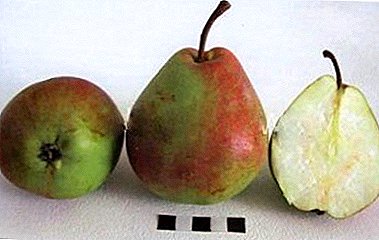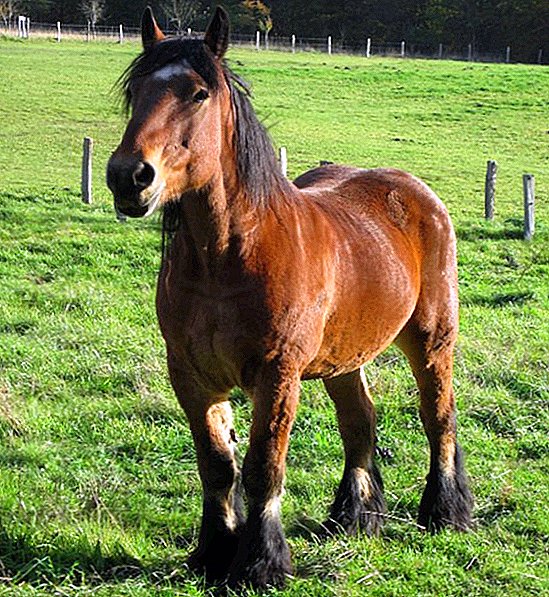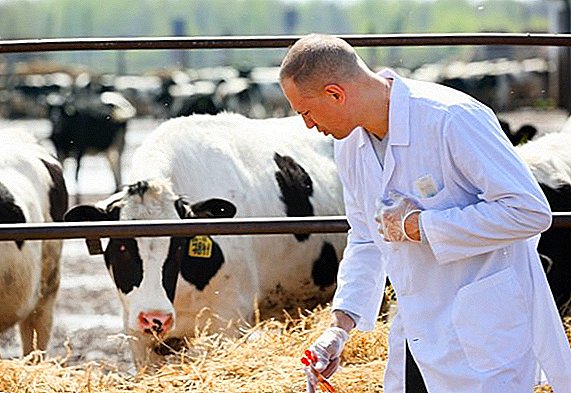 Practically every farmer is aware of cows infected with dangerous viruses that caused an epidemic throughout the herd. Often, the pathogens of these diseases are dangerous for humans. About one species of pathogenic microorganisms - Brucella - will discuss in this article.
Practically every farmer is aware of cows infected with dangerous viruses that caused an epidemic throughout the herd. Often, the pathogens of these diseases are dangerous for humans. About one species of pathogenic microorganisms - Brucella - will discuss in this article.
What is this disease
Brucellosis is a dangerous disease, carried by cattle (less often goats and dogs), its pathogens affect the nervous system, the musculoskeletal system and the reproductive system of animals.
Important! Brucella bacteria retain their activity in frozen meat for up to 5 months, in milk and dairy products - 2.5 months, and in the soil - up to six months. You can completely destroy them by boiling, processing disinfectants and under the influence of sunlight.
How does the infection occur?
The most common source of infection is a sick cow, which was admitted to the herd without prior veterinary inspection. The spread of bacteria occurs through urine, feces, amniotic fluid, blood, and animal sperm. 
Brucella penetrate the body through wounds, mucous membranes, as well as after they have consumed contaminated water or feed. It should be noted that if the cow has a strong immunity, and the dose of pathogenic microorganisms is small, then the animal's body gets rid of the virus without any consequences.
Find out what are the symptoms, treatment, methods of preventing diseases of cows.Pathogenic microorganisms first infect the lymphatic system of animals - at this stage, timely treatment in most cases gives a positive result. Then brucella enter the bloodstream and begin to infect the internal organs of the cow. Foci of inflammation are formed in the kidneys, liver, pancreas and lungs, which cause various disturbances in the functioning of these organs.
After the end of the acute stage of the disease, brucella concentrate in the lymph nodes (the largest number is in the pelvic lymph nodes), uterus, udder and spleen.

Stages and symptoms
This disease most often has hidden symptoms that are difficult to diagnose in the early stages. Each breeder should be alerted by repeated abortions in cows and the birth of unviable calves.
The appearance of such signs should be a reason for contacting a veterinary clinic with a mandatory referral for examination of the afterbirth, aborted fetus or colostrum samples.
Get familiar with udder diseases, joint diseases and hoof diseases in cows.External signs of the disease are most pronounced in cows - after a miscarriage provoked by brucella, an inflammatory process begins in the cow's uterus, which also affects its fallopian tubes, as a result of which the animal becomes temporarily infertile, but if the inflammation is not removed in a timely manner, this process is irreversible.
At the same time, sick cows have loss of appetite, lethargy, a sharp increase in body temperature, pain in the extremities and inflammatory processes in the joints - bursitis and arthritis are formed.
After some time, cows are diagnosed with tendovaginitis and hygromas, and in bulls - testicular swelling, numerous inflammatory processes in the prostate gland and appendages, as well as subcutaneous abscesses with signs of necrosis.
Did you know? The most expensive meat is marble beef, which is obtained from Vagyu cows. Every day, each representative of this breed is fed with selected herbs, watered with the purest water and beer, and besides this, before bedtime, each female will have a relaxing massage.
Sharp
This period lasts 30-60 days. It is characterized by a sharp increase in body temperature. The appearance of brucellosis at this stage is difficult to see with the naked eye, however, when examining the internal organs, the veterinarian may notice an increase in the liver and spleen.
At the end of the acute stage, enlarged lymph nodes may be noticeable, especially the pelvic, and inflammatory processes in the genitals begin. If an animal has a strong immune system, then infection can proceed completely unnoticed, and brucella over time disappear without a trace from their blood. 
Subacute
Subacute stage has a longer period - 60-90 days. It is characterized by wavy manifestations of the disease - a sharp deterioration in the well-being of animals gives way to improvement. But despite this, it is already possible to diagnose the appearance of brucellosis - inflammation of the joints, subcutaneous abscesses and discharge from the genital organs of brown color.
Chronic
This stage of brucellosis is characterized by the manifestation of external signs of the disease for three or more months. Sick animals lose their appetite, become lethargic, nervous. The naked eye becomes noticeable symptoms of the disease - inflammation of the joints, blood discharge from the genitals, subcutaneous tumors. Constant pain in the limbs makes cows restless.
Important! The symptoms of brucellosis are in many ways similar to other dangerous diseases, such as tuberculosis, salmonellosis, and leptospirosis, therefore, when prescribing treatment, one should focus only on the results of several clinical studies.
Diagnostics
Diagnosis of brucellosis is carried out using serological and bacterial studies, which are performed in laboratory conditions. The most common methods of detecting brucella in the blood of animals are Wright's reaction and the Byrne allergy test. 
Wright Agglutination Reaction (RA)
Wright's reaction is the official method of diagnosing brucellosis in humans and animals, which is used throughout the world. The peculiarity lies in the fact that it can be used to diagnose this disease at the very beginning, as well as several years after infection, that is, when brucellosis becomes chronic.
Learn how to measure the temperature of a cow, how to take and what biochemical analysis of the blood of cows.Wright's reaction is carried out as follows:
- An isotonic solution of sodium chloride is added to the venous blood of a sick animal (for cattle, four dilutions are used in a ratio of 1:50).
- Then add 10 billion killed Brucella bacteria, after which the contents of the tubes are thoroughly shaken.
- Next, the tubes are placed in a thermostat and kept at a temperature of +38 ° C for 5-10 hours, after which they are stored for a day at room temperature.
A positive result is the precipitation, the appearance of flakes and lumps in test tubes with biomaterial, and the intensity of suspension formation is estimated according to a special scale for evaluating the agglutination reaction. 
Allergic test
This diagnostic method is used in cases where the results of serological tests for the presence of antibodies to brucella in the body of a cow are negative or their reliability is questioned. Allergic test is carried out as follows:
- 0.1 ml of protein extract extracted from Brucella bacteria is injected into the area of the scapula of the animal.
- On the second day after the test, the reaction can already be observed - the redness at the injection site, the formation of compaction and the release of infiltrate are considered positive.
Did you know? Cows have their own language in which they express their emotions or communicate with each other. Scientists have identified more than ten types of mooing, which was used by animals in various situations.
Due to the fact that this type of diagnosis of brucellosis often shows a positive result in vaccinated cows, the final diagnosis is made only after repeated serological studies. 
Is it possible to cure
If laboratory diagnostics confirmed the presence of brucella in the blood of animals, then antibiotic therapy should be started immediately, most often veterinarians prescribe tetracycline antibiotics and drugs containing chloramphenicol.
Also required various immunostimulants and immunomodulators. Death of the disease is possible if the cow is exhausted, her diet is poor and monotonous, and sanitary conditions in the stall are broken.
Find out what are the symptoms and how to treat: EMCAR, allergies, thorn, bluetooth, leptospirosis, acidosis, malignant catarrhal fever, avitaminosis, anaplasmosis, anterior pancreatic atony, babesiosis, telasiosis, parainfluenza, lichen, vaginitis, actinomycosis, cows, telosis, parainfluenza, lichen, vaginitis, actinomycosis, cows, telosis, parainfluenza, lichen, vaginitis, actinomycosis, cows, telosis, parainfluenza, lichen, vaginitis, actinomycosis, babesiosis, fever, parainfluenza, lichen, vaginitis, actinomycosis, babesiosis, fever, parainfluenza, vaginitis, actinomycosis.Most often cows with such a diagnosis are sent for slaughter, and the room in which the infected animals lived is thoroughly disinfected.
Such radical methods are due, above all, the high cost of drugs, as well as the enormous risk of infection of the entire herd from one sick individual. 
What is the danger to humans
Not only animals can be affected by brucella. When drinking contaminated milk, meat and cheese, pathogenic microorganisms enter the human body and infect its internal organs.
The probability of infection with Brucella is significantly higher among workers in livestock farms who are in contact with sick animals.
Familiarize yourself with the basic ways of processing milk.Symptoms and stages of development of the disease in humans are similar to cattle - fever, fever, lethargy, inflammatory processes in the internal organs, subcutaneous tumors and pain in the joints and muscles.
When such symptoms occur, it is important to promptly consult a doctor for clinical trials for the detection of antibodies to brucellosis.  Joint pain may be a symptom of brucellosis
Joint pain may be a symptom of brucellosis
Prevention and vaccine against brucellosis of cattle
You can protect your farm from brucellosis infection by fulfilling the following requirements:
- Regular vaccination of cattle. Vaccination is not an absolute guarantee of the formation of immunity that is resistant to brucella, but with its help you will be able to prevent an epidemic among the whole herd.
- Compliance with sanitary standards of animals, which include mandatory cleaning in the stalls and regular disinfection of premises.
- Regular examination of animals by a veterinarian. In addition, a sick cow should be immediately isolated from other animals until it is completely cured.
- In contact with animals, all farm workers should always use protective clothing — disposable gloves, gowns and rubber boots.
- After an abortion or miscarriage, the room should be immediately disinfected, and the placenta and the abortive biomaterial should be destroyed or sent to the veterinary laboratory to conduct the necessary research.
- The acquisition of young or new animals in the herd - only from proven breeders. Before meeting with the rest of the herd, the animal must be in quarantine for 7-14 days.
Video: Brucellosis
Reviews

Brucellosis is considered established when isolating a Brucella culture from a biomaterial, a positive bioassay, or positive results from the following serological studies of unvaccinated animals: cattle (buffalo, yak, zebu), camels and horses - simultaneously in REED and RA with an antibody titre of 200 IU / ml and higher; sheep and goats in RA with an antibody titer of 100 IU / ml and higher; deer (deer) and dogs — in RA with an antibody titer of 50 IU / ml or higher; animals of all kinds - in the RSK in the dilution of serum 1: 5 and above.
With positive results of serological studies of unvaccinated animals: cattle (buffalo, yak, zebu), camels, horses - only in RA with an antibody titer of 50 ... 100 IU / ml; sheep, goats, deer (deer) in RA with an antibody titer of 25 ... 50 IU / ml - re-examined after 15 ... 30 days. With increasing titers, the disease is considered established;
If the credits remain the same, resort to additional research (according to the approved Rules).
The disease is considered to be established if previously unvaccinated animals that react positively in RA with an antibody titer of 100 IU / ml and above or (and) in RSK (RDSK) at a dilution of 1: 5 and above, have been identified in unsuccessful brucellosis in cattle herds.














